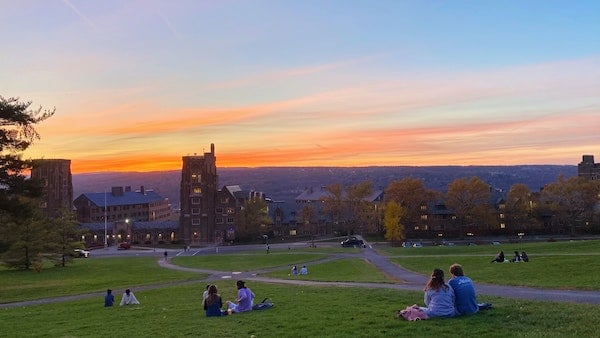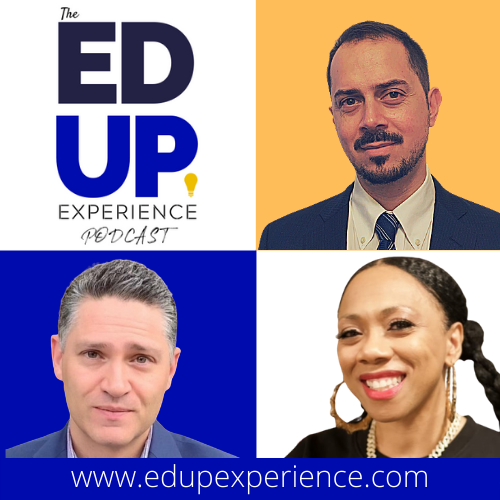Published on
Doubling Down on the Residential Experience

Now that learners have spent a year in the remote environment, they’re looking to return to the classroom and the residential experience. With the new environment becoming more hybrid, it’s important for institutions to ensure they’re delivering the best experience for students—no matter who they are. In this interview, Dr. Joe Sallustio and Liz Leiba speak with Sean Decatur about the importance of the residential experience, how the liberal arts are critical to the future of higher ed and how to measuring progress as we move forward.
EdUp Experience: Kenyon College recently received a $100 million donation. Can you talk a bit about how this happened and the significance of this on the residential experience?
Sean Decatur (SD): One of the big lessons we’ve had over the course of the past year is that everyone has developed an appreciation of what it means to be a residential institution, what it means to live and learn together in community, and that has several different dimensions.
There’s the traditional dimension of what it means to have a shared experience in the classroom, to form good friends and lifelong connections—there’s a real tight knit community that develops there. That’s something people are looking forward to reestablishing. At the same time, we’ve also learned that many of our students rely on the college not just as an educational institution, but also for housing, food security and healthcare.
In that sense, the residential experience allows our students to really immerse themselves in the academic and intellectual aspects of their work. At the same time, it provides a level playing field for many of these issues.
At this particular moment, we’re able to say we’re confident about our future, about the future of residential education and its importance to our students and their learning. This donation is really a central piece of that. Despite the disruptions of the past year, all the value that comes from being a residential institution is something that we will continue to value as we look to the future.
EdUp Experience: What role do you think that the smaller, liberal arts schools are going to play going forward and what that means for your students?
SD: The small liberal arts colleges are some of the strengths of the larger, American higher education system, and that sometimes flies under the radar. We typically produce graduates who go on to leadership in disproportion to our size. There have been interesting studies, specifically in the natural sciences, which show that graduates who go onto get PhDs are disproportionately graduates of small liberal arts colleges.
Some of that comes from being institutions where the close connections between faculty and students form very early on. That empowers students to be not only more active in their own learning, but also to take on leadership positions inside and outside of the classroom. This is a place where have an amazing depth of experience that students might not have gotten at a bigger place. Small institutions do an excellent job with that type of education.
EdUp Experience: Does it surprise you that everybody wants to be a social media influencer, instead of going to work in a “real job?”
SD: What I find fascinating about that is that in many ways, it’s a good example of a type of opportunity that didn’t exist years ago. But there’s a notion, when we think about linking education to career, that the shiny object of the moment are what often get people excited. There are professional and economic opportunities opening up in areas A, B and C. How do we actually make sure we are funneling folks to those areas? It often obscures the fact that the things that are evergreen, like the ability to write well, is going to serve well, regardless of the long-term directions that students may take.
One of the challenges we have is making sure that high school students, as well as college students, understand that the investment in those long-term skills is critical. The shiny objects of the moment may or may not exist in a couple years. So, part of our goal has to be getting folks to realize what’s going to sustain them in the long term.
EdUp Experience: Can you talk about your diversity and inclusion initiatives that are going on?
SD: We certainly have the goal of building a campus community that’s reflective of not only the national demographics and community, but also our global community. Kenyon attracts students from all over the country and the world. We try to make sure that it is a racially and socioeconomically diverse student body.
Even though we have some work to do to continue making progress on the diversity front, the inclusion and belonging piece is where the challenging work happens. Kenyon is comprised of about 20% students of color from the US and another 10% international students. Those numbers have really gone up substantially over the past 15 years or so. On the faculty front, we’ve made even more progress. When we think about attracting faculty and staff, we want to make sure there’s an extra effort to bring folks to Kenyon.
On the student recruitment front, we developed a program 15 years ago called The Kenyon Educational Enrichment Program. We recruit students who receive a scholarship with no loan or work requirements and work closely with a staff and faculty to get close mentoring and support. It’s been a way for us to recruit very strong students from underrepresented groups and ensure we support and retain those students as they transition into college. That’s been an important piece for us.
You have to find creative ways to create pathways that get people in the door. Once folks are here, part of the real challenge is then building a truly inclusive community. Everyone needs to have a sense of belonging. We have to be intentional about creating opportunities for people to experience, to engage in dialogue across difference.
EdUp Experience: Can you speak to us about the development of the strategic plan for 2020-2021?
SD: Empowering faculty to be real partners in building inclusive community has been an effort for us. If we’re really going to make progress on inclusion as a priority, it really has to be something that everyone accepts as a priority in their work. So, there was a change to the evaluation criteria to promote or grant tenure to faculty. Part of this is the idea that if you really want to prioritize something, you have to link it to the campus’ evaluation systems. Otherwise, it’s an empty priority because it has no real consequences. It was made an explicit piece of the evaluation process to recognize the work that someone is doing in making their classrooms more inclusive. The work that someone is doing to help advance the college’s priorities for diversity, equity and inclusion. The idea is that this is something we’re asking people to do as an extra thing, but it’s becoming an expectation.
Our faculty have also organized what’s called the Kenyon Equity Institute. It’s a week-long intensive exploration of issues of racial bias, inequity and social justice, very much with the idea that folks are being vulnerable and understanding of their own privilege with respect to these issues. But also with the idea of what they can do to be better actors and allies within the campus community. Again, the notion is that this is work that matters not just in the classroom, but in the everyday interactions that folks have on campus.
EdUp Experience: How do we know that we’ve met certain measures?
SD: I often frame it as a gap between where we are now and where our aspirations are. We want to continually make that gap smaller, which both means that we always need to keep our aspirations in mind, and know which direction we’re heading and know that we’re moving in that direction. But it also means that we have to recognize that there are still going to be things that we don’t like about our current environment. There are things that are going to be difficult incidents on campus. In fact, paradoxically, the more honest and open we are about confronting some of these issues, the more difficult incidents we may have.
I’ve had this conversation with some leaders on campus. How do we know if we’re actually making progress on building belonging? One of the contradictory things is that, actually, we may have more difficult conversations. One of the things that’s a measure of progress is that people don’t let those things go unspoken anymore. They’re actually willing to confront problems or issues out in the open, where six or seven years ago, they might have been willing to just let it slide. As we move closer to our aspirations, one of our challenges is that the work actually does get harder. Some of the things that are difficult about living in the moment actually do get more difficult the closer to our aspirations we get.
EdUp Experience: What advice would you give for colleges looking to empower students, and help them find their voice and engage in some of these brave conversations?
SD: There are some ways in which our students are just terrific at taking on issues that are important to them. I’m always deeply appreciative of the care, thought and engagement that students have with problems we’re collectively trying to solve.
Where things get more difficult is how it impacts their day-to-day lives. This is one of the challenges of being a very small campus and community. Everyone has to live together. There’s a natural desire for folks to try to find common ground and to get along. But that sometimes means setting aside things that are difficult issues to work out among each other, just in the spirit of figuring out how to navigate and move forward.
Developing that skillset to engage in disagreement, while actually still feel like you are getting along is something we need to work on. Our students are great at advocating collectively on things they see as important for the student community. But they struggle a little bit more with advocating within the student community for things that they’d either like to see changed or just in places where there are disagreements among different groups of students.
EdUp Experience: What do you see as the future for higher education?
SD: One thing that I hope, both from a policy standpoint, and as something that those of us in higher education can do a better job at articulating, is that we don’t clearly spell out the broad diversity of higher education institutions in the U.S. And spelling that out in a way that also understands and values the different roles that different institutions play.
One of the strengths of higher education in the U.S. is that we have excellent institutions that do the work that two-year colleges are doing, that do the work that R1 research institutions are doing, that do work like Kenyon and small private colleges are doing. So, being able to recognize and honor that diversity, yet also recognize the differences between institutions is important. We can improve in the way that we honor those distinctions and celebrate and recognize the unique roles that different types of institutions play.
This interview was edited for length and clarity.
Listen to the full interview here.

Disclaimer: Embedded links in articles don’t represent author endorsement, but aim to provide readers with additional context and service.
Author Perspective: Administrator



